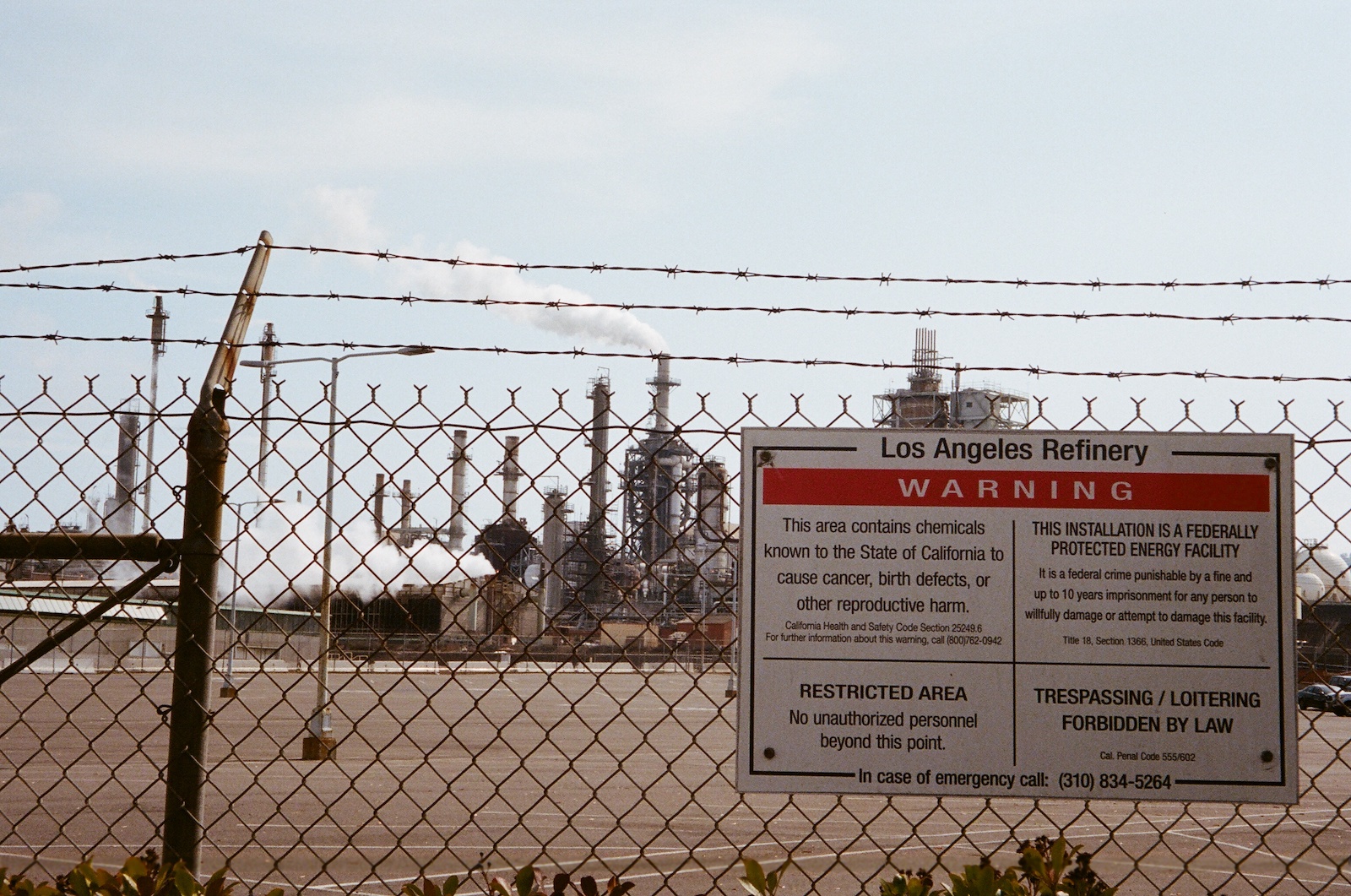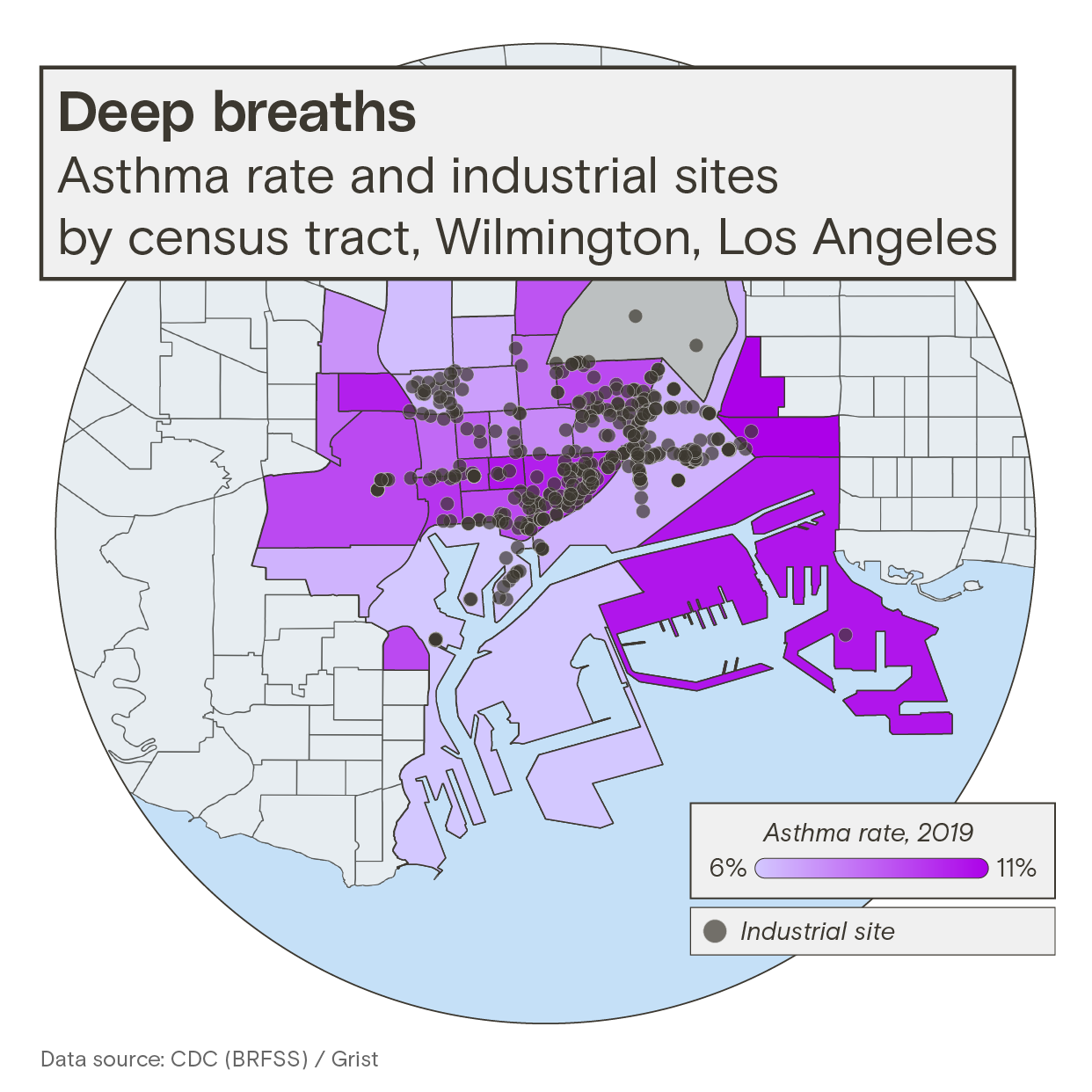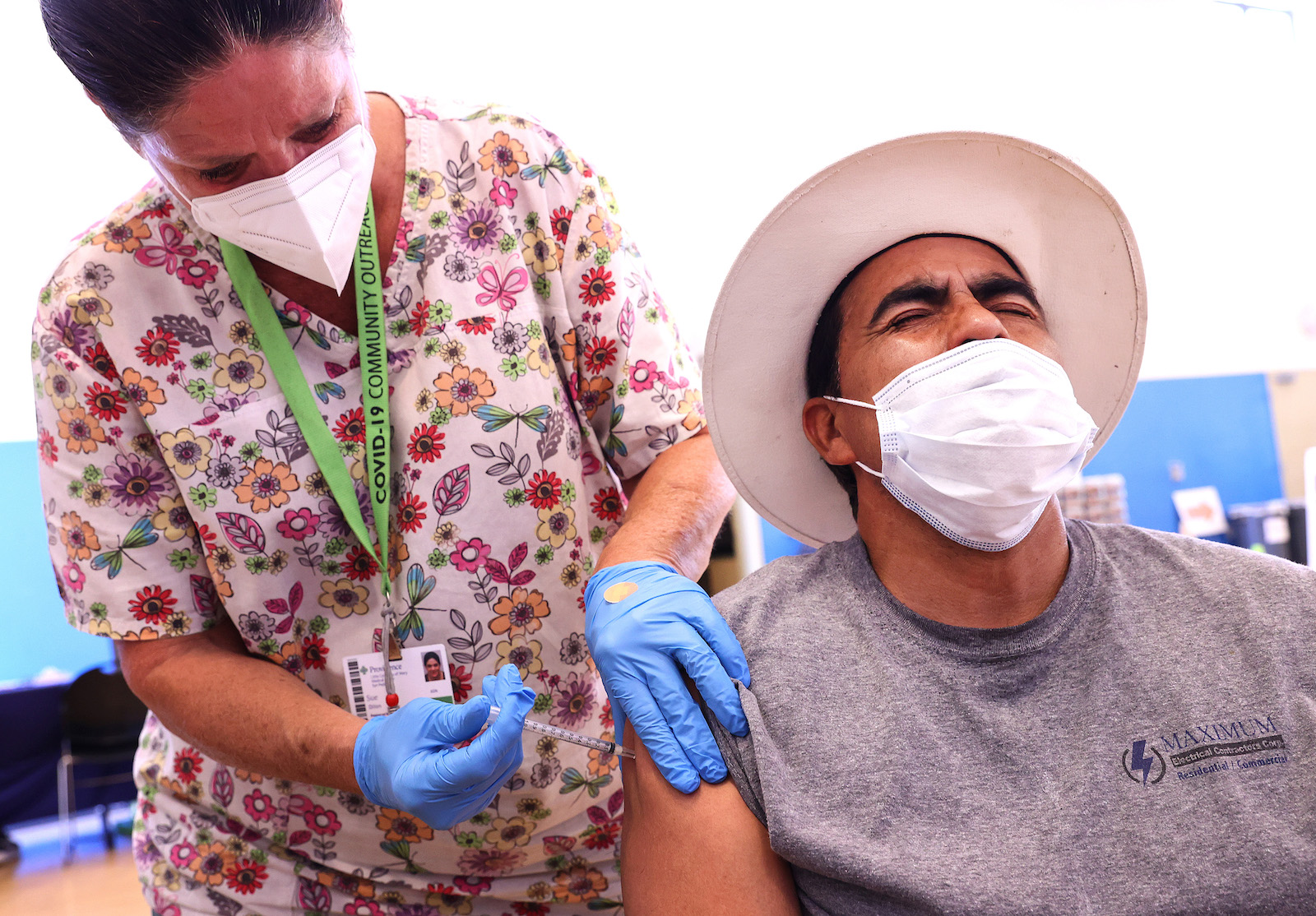This story is published in collaboration with KCET.
Lee este artículo en español aquí.
As the country erupted in protest against racial and economic inequalities in June 2020, two 22-year-olds and their unborn child lost their lives in the Los Angeles neighborhood of Wilmington, California. They weren’t killed by police or by COVID-19, but the place where they died embodied those same inequalities.
The young couple, Issac Muriel and Chyna Waddle, died in a fiery crash, their small gray sedan crumpled under a three-ton big rig truck on the Pacific Coast Highway. The Wilmington stretch of that highway is not the two-lane, happy-go-lucky road that has become synonymous with California’s coast, but rather a six-lane behemoth that serves as a 24-hour artery for semi-trucks headed to and from the Port of Los Angeles on the edge of Wilmington’s industrial corridor. As Muriel and Waddle took their last breaths, to their left and right sat two refineries that spewed out a combined average of 400 pounds of toxins into the air every day that year.

Muriel and Waddle were just two of 40 residents in the small, 8.5-square-mile port community who lost their lives that month. The 55,000-person community, where 90 percent of residents are Latino and just 4 percent are white, is no stranger to tragedy. In the six years leading up to the coronavirus pandemic, an average of 272 residents died in Wilmington every year. In the last two, 390 people perished each year — an increase of 45 percent over the previous average. That dwarfs even the 30 percent jump in deaths seen across Los Angeles County over that same period.
With the country approaching 1 million lives lost to COVID-19, Americans have been offered little time to grieve and process the death around us. A close look at Wilmington, a place contending with many overlapping issues contributing to premature death, shows that the pandemic’s true toll extends beyond deaths narrowly attributed to COVID-19. It can also help prevent similar loss in the future.

Wilmington is an oceanfront community that experiences none of the social, economic, and public health benefits typically associated with the title. To the south and west lie the more prototypical beachfront communities of San Pedro, Rancho Palos Verdes, and Palos Verdes Estates. They’re home to five-star resorts, state-protected green spaces, and even a Trump National Golf Club.
Of the city of Los Angeles’ 35 community plan areas, Wilmington has the sixth-lowest life expectancy. Residents who live just six miles away in Rancho Palos Verdes and in Palos Verdes Estates — a 15-minute drive — are expected to live seven years longer. Sometimes this reality feels hard to escape, according to Jesse Marquez, a lifelong Wilmington resident.

“It may sound crazy,” Marquez, a community organizer, said, “but sometimes it does feel like sickness is in the air.”
The pandemic has only intensified this feeling. A Grist analysis of California Department of Public Health data has found that over 2020 and 2021, Wilmington experienced 236 excess deaths — the number of all-cause deaths beyond what would have been expected in a typical year, before the pandemic. Adjusted for population, Wilmington experienced roughly 430 excess deaths per 100,000 residents, a number that eclipses the population-adjusted excess deaths not only of its neighbors, but also of the state of California overall.
This is despite Wilmington’s incredibly young population, which is the fourth youngest of the county’s 264 neighborhoods. The average Wilmington resident is 17 years younger than the average resident of San Pedro, Rancho Palos Verdes, and Palos Verdes Estates — a fact one might have expected would spare the community from many of the ravages of the past two years.

Using excess death modeling, global researchers estimate that the world has seen double or even quadruple the number of deaths reported in official tallies since 2020. Excess death modeling works by comparing a year’s death count in a given population to the same population’s baseline annual death count — the average expected in a “normal” year. In doing so, it can illuminate the breadth of our current public health crises in a more thorough way than official COVID-19 tallies.
For example, according to the Los Angeles County health department’s public database, 104 Wilmington residents died with COVID-19 in 2020 and 2021 — but that accounts for just 40 percent of all excess deaths in the community over that time. Across the county, by contrast, COVID-19 accounted for nearly 75 percent of all excess deaths.
The other 130 excess deaths tell the story of a 40-percent-immigrant community that is home to 300 polluting sites and deadly levels of air pollution. It’s a story compounded by high levels of poverty, food insecurity, and lack of access to health care. According to a Grist analysis of the health department’s death data, 80 of Wilmington’s excess deaths stemmed from homicides, accidental and unintentional injuries, Alzheimer’s, liver disease, heart disease, high blood pressure, strokes, and diabetes — all of which research has shown to be exacerbated by high levels of pollution.

Wilmington fuels the entire country — an estimated 40 percent of all U.S. imports move through the nearby port — and its residents are the ones who pay the price. In 1981, 500,000 containers moved through the Port of Los Angeles; today that number is more than 10 million. Your phone, car, and your furniture may have been trucked through Wilmington’s streets. The oil and gas that moves you across the country could’ve been refined on its soil.
Indeed, more than 18 percent of Wilmington’s total land area is taken up by oil refineries — nearly 3.5 times more area than is dedicated to open and accessible green spaces, according to a Grist analysis. Since 2000, more than 16 million pounds of toxic chemicals, primarily hydrogen cyanide, ammonia, and hydrogen sulfide, have been dumped into Wilmington’s air from industrial sites in the city, according to the Environmental Protection Agency, or EPA.
One sign of the structural issues leading to early death in Wilmington is where people die. Over the last two years, Wilmington saw an excess of 50 people die in their homes compared to normal years, which points to a lack of access to both preventive care and end-of-life care. According to the CDC’s 2019 Behavioral Risk Factor Surveillance System, an estimated 28 percent of Wilmington residents are uninsured — more than three times the national average. Additionally, nearly 80 percent of Wilmington residents are native Spanish-speakers, according to the 2019 American Community Survey.
“There are layers here,” said Fatima Iqbal-Zubair, a former environmental science teacher who is running to represent Wilmington in California’s state assembly. “Folks aren’t documented, they’re often excluded from health insurance programs, and they’re less likely to have true political representation.”
“All these social factors increase peoples’ risk for death,” she added.

The home deaths also suggest an undercount in the community’s COVID-19 deaths: People who die at home are less likely to go through death investigations, which would include postmortem COVID-19 testing. A recent study published by the Boston University School of Medicine in September, which analyzed death records from 2,100 U.S. counties covering 97 percent of the country’s population, found that there were more excess deaths, including COVID-19 deaths not accurately included in COVID-19 death counts, in counties with limited access to health insurance and health care services, as well as in counties with more deaths that occurred at home.
The risk of early death from pollution in Wilmington preceded COVID, and likely made the pandemic worse. According to the EPA’s Risk-Screening Environmental Indicators tool, which analyzes how industrial facilities affect human health, the health risk from industrial pollution in Wilmington is 21 times higher than it is in neighboring Rancho Palos Verdes and Palos Verdes Estates.
According to a ProPublica analysis of EPA data, a 425-acre refinery owned by the Phillips 66 Company contributes to about 87 percent of the city’s excess cancer risk, mostly due to its benzene emissions. Benzene, a colorless liquid that is burned off during oil and gas production, is one of the most cancerous chemicals used in industrial operations, known primarily to cause leukemia and other cancers of blood cells.

“Cancer and death is something we constantly hear about almost daily [in Wilmington],” said Marquez, who learned the basics of environmental science from walking his community rather than from a textbook. “It’s hard not to be bothered and affected by it every day. How can we end up with so many of our neighbors having breast cancer, lung cancer, leukemia — dying — and act like it is normal?”
A 2017 study found that the benzene emissions from five refineries in the greater area around Wilmington were being undercounted by factors ranging from 3.2 to as much 202. Emissions appear not to have abated much since: According to the refinery’s 2020 emissions report released to the EPA, Phillips 66’s Wilmington plant emitted benzene at an amount that was more than double its 2019 rate.

While death has exploded in the community lately, Veronica Terriquez, director of UCLA’s Chicano Studies Research Center, traces the city’s current reality to its past disinvestment.
“The pandemic may have exacerbated inequalities in Wilmington, but the city’s poor life outcomes are historical,” Terriquez said. “It’s not an accident in a place where residents have little political power to leverage, that it’s being hit on all sides with environmental and social neglect.”
The land on which Wilmington sits, annexed through Western expansion and the slaughtering of Indigenous peoples, was dredged in the late 1870s to create what is now the biggest ocean port in all of North America. Within two decades, a network of oil drilling and oil refineries popped up throughout the city.
The quickly expanding industrial community became the West Coast’s home for car and ship manufacturing as well as U.S. military operations. Today, remnants of war and industrial waste are wedged between homes, schools, and businesses. There’s a 160-year-old crumbling powder room that held gun ammunition and powder during the Civil War, and the city’s junior college campus, which once held thousands of Italian prisoners of war during World War II. As Wilmington’s industrial identity was crystallized in the early 20th century, the city of Los Angeles swooped in to annex the community and make it a part of the city’s municipal system, capturing much of its revenue in the process.

A social transformation followed the city’s slow industrial expansion: white flight. The city’s white residents, which had historically been a majority, could now afford to sell their homes — their values boosted by the Los Angeles address — and move farther away from the pollution. Many settled in the neighboring cities of Palos Verdes Estates and Rancho Palos Verdes. The new class of residents, most of whom were immigrants, inherited the mess they left behind.
Because Wilmington’s city council district is geographically isolated from the rest of the city of Los Angeles, many residents can go their whole lives without ever knowing they’re technically LA residents, according to Bryant Odega, a climate organizer with the Sunrise Movement currently running to represent Wilmington on the Los Angeles City Council.
“Black and brown people in Los Angeles have been exposed to pollution and all the things that cause cancer, asthma, and health issues and excluded from all the pieces that make up a healthy community,” Odega said, adding that Wilmington’s geographic isolation makes it harder to build “community power.”

While Wilmington’s position as the city of Los Angeles’ industrial dumping ground underpins its poor health outcomes, it can also create a cycle of dependency. Industrial operations make up at least 40 percent of Wilmington’s business profile, according to the U.S. Census Bureau. Becoming a port or oil worker is the “main way to enter the middle class” in the area, Odega explained.
The Port of Los Angeles supports employment for more than half a million people throughout Southern California and 1.6 million worldwide. The five refineries surrounding Wilmington alone employ another three to five thousand people. Industrial businesses also spend millions of dollars in the area, funding everything from specialty classes at the local high school to summer youth programs, community mental health organizations, health clinics, and school repairs.
“Residents have been left with a false choice: either accepting these harms to feed their families and pay for health care or falling into deep poverty,” Odega added.
Terriquez argues that Wilmington offers a window into one of our country’s biggest philosophical dilemmas: what deaths we see as acceptable versus those we should spend resources preventing. “When [politicians] look at a community like Wilmington, a vulnerable community going through traumas — health trauma and mental health trauma — they write them off,” Terriquez said. “They treat their lives as expendable.”

But while political leaders may have historically ignored the needs of Wilmington, today there is a new crop of residents, activists, and politicians dreaming together and working toward a healthier community. The vision, according to Iqbal-Zubair, is a just transition away from the extractive fossil fuel economy on which the city has long relied. Drawing on the calls for a “regenerative” economy made by labor and environmental activists in the 1970s, the vision calls for the end of fossil fuel extraction and investment into small-scale local production, food systems, and clean energy.
“I believe we need to get to a world where we don’t have refineries, oil wells, and massive polluting ports,” Iqbal-Zubair said. “I want to see a Los Angeles that gets all its energy from renewable sources: for Wilmington residents to step outside to see solar panels or wind farms.”
“I envision a place where parents can let their kids go outside and maybe leave their door open and not be worried about violence or unbreathable air,” she continued. “We want people to feel safe in their community.”
Marquez agrees. His optimism for a different, healthier version of Wilmington keeps him pressing on despite a lifetime of watching his home being neglected. “You can have all the Ph.D.s, scientists, researchers, and medical professionals in the world telling us what’s wrong,” he said. “But it is left up to us — the community — to do anything about it.”
This article was produced as a project for the USC Annenberg Center for Health Journalism’s 2021 Data Fellowship.




